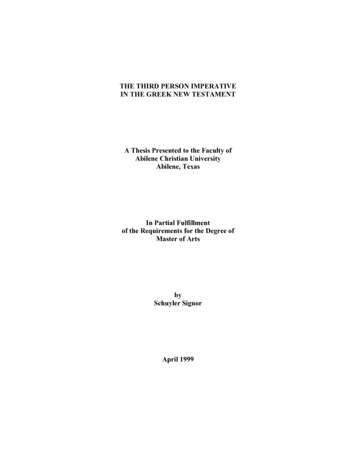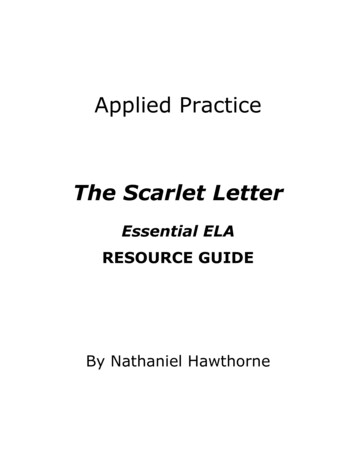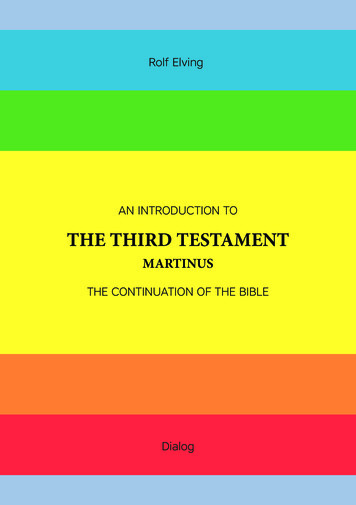
Transcription
THE THIRD PERSON IMPERATIVEIN THE GREEK NEW TESTAMENTA Thesis Presented to the Faculty ofAbilene Christian UniversityAbilene, TexasIn Partial Fulfillmentof the Requirements for the Degree ofMaster of ArtsbySchuyler SignorApril 1999
2ABSTRACTThe third person imperative in the Greek New Testament is generally discussedwith the second person imperative without distinction. The English language has no formcorresponding to the third person imperative, and therefore must employ an adequatesubstitute to communicate the same meaning and force of the original text. Thus, it isincumbent upon the exegete to discover how the third person imperative functionsgrammatically and contextually as a distinct form.I examined every occurrence of the third person imperative in the Greek NewTestament in conjunction with the Septuagint and selected sections from first centurywriters Philo and Josephus. I hypothesized that unless third and second personimperatives functioned differently, at least in some instances, the presence of both formswould be superfluous. Thus, each occurrence was examined with regard to syntax,semantics, and pragmatics.The study demonstrated that the third person does function differently from thesecond person imperative other than in the expected sense of addressing a third partybeyond the immediate listening/reading audience. In actuality, its capacity for thispurpose is infrequently employed and easily provided for by other forms. The primaryfunction of the third person imperative is to add emphasis for the immediate audienceeither with regard to who (in the audience) is responsible to carry out the injunction (whatI have called “subject transfers”) or what is to be done by the audience (what I havecalled “object transfers”).I also considered how the speakers/writers chose the (present and aorist) “tense”forms used with the third person imperative. I found nothing distinctive about thisprocess in contrast to the second person. However, I did find the traditional view lackingthat asserts a direct correspondence between the speakers’/writers’ choice of these twoforms and the existence or the non-existence of the action in reality.Finally, I applied the results of this study to the question of translating the thirdperson imperative into English.
3TABLE OF CONTENTSChapterI.QUESTIONS AND ISSUES . . . . . . . . . . . . . . . . . . . . . . . . . . . . . 5The Question of Mood . . . . . . . . . . . . . . . . . . . . . . . . . . . . . . . . . .7The Question of Tense . . . . . . . . . . . . . . . . . . . . . . . . . . . . . . . . . .8Critical Issues . . . . . . . . . . . . . . . . . . . . . . . . . . . . . . . . . . . . . . . . . 11Categorizing Imperatives . . . . . . . . . . . . . . . . . . . . . . . . . . . . . . . . 15Translating the Third Person Imperative . . . . . . . . . . . . . . . . . . . . 16II.III.IV.Presuppositions and Method . . . . . . . . . . . . . . . . . . . . . . . . . . . . .17SYNTACTIC AND SEMANTIC CATEGORIESOF THE THIRD PERSON IMPERATIVE . . . . . . . . . . . . . . . . .20Emphatic Subject Transfer . . . . . . . . . . . . . . . . . . . . . . . . . . . . . .22Emphatic Object Transfer . . . . . . . . . . . . . . . . . . . . . . . . . . . . . . .27Conditional Constructs . . . . . . . . . . . . . . . . . . . . . . . . . . . . . . . . .35PRAGMATIC CATEGORIESOF THE THIRD PERSON IMPERATIVE . . . . . . . . . . . . . . . . .41Levels of Force . . . . . . . . . . . . . . . . . . . . . . . . . . . . . . . . . . . . . . .41Responsible Party . . . . . . . . . . . . . . . . . . . . . . . . . . . . . . . . . . . . .45Two Case Studies . . . . . . . . . . . . . . . . . . . . . . . . . . . . . . . . . . . . .46FUNCTION OF THE PRESENT AND AORIST FORMSIN THE THIRD PERSON IMPERATIVE . . . . . . . . . . . . . . . . . .52Context . . . . . . . . . . . . . . . . . . . . . . . . . . . . . . . . . . . . . . . . . . . . . . 53Nature of the Material . . . . . . . . . . . . . . . . . . . . . . . . . . . . . . . . . .55Grammar . . . . . . . . . . . . . . . . . . . . . . . . . . . . . . . . . . . . . . . . . . . .57
4V.TRANSLATING THE THIRD PERSON IMPERATIVE . . . . . .60Obligatory Level . . . . . . . . . . . . . . . . . . . . . . . . . . . . . . . . . . . . . .62Hortative Level . . . . . . . . . . . . . . . . . . . . . . . . . . . . . . . . . . . . . . .65Optative Level . . . . . . . . . . . . . . . . . . . . . . . . . . . . . . . . . . . . . . . .66AppendixA.OCCURRENCES OF THE THIRD PERSON IMPERATIVE . . . 67B.CLASSIFICATIONS OF THE THIRD PERSON IMPERATIVE . 68BIBLIOGRAPHY . . . . . . . . . . . . . . . . . . . . . . . . . . . . . . . . . . . . . . . . . . . . 69
5CHAPTER IQUESTIONS AND ISSUESThe primary purpose of translating is to communicate the meaning of a given textor verbal expression of a source language into a text or verbal expression of a receptorlanguage. There are two essential elements in every language: form (whether oral orwritten) which includes the phonological, grammatical, and lexical systems of thelanguage, and meaning which is the message the form communicates.1There are two fundamental problems in communicating the meaning of the sourcelanguage into the receptor language. The first is the lack of strict correspondencebetween the elements of form and meaning in both languages, which is sometimes called“skewing.”2 Factors that influence skewing include the multifarious nature of the lexicaland grammatical features (including idiomatic and figurative language),3 authorial intent(which may or may not be fully expressed in the form the author has chosen),4 andcontext (which shapes authorial intent and choice of form). This last factor covers allcultural and immediate precipitating influences on the language of the text; that is, itincludes all extralinguistic or non-semantic elements. Thus, the meaning of a text isdetermined by analysis in two categories: semantics (the language of the text itself) andpragmatics (the extralinguistic factors, including authorial intent and context). These twocategories must be distinguished, but not separated.5Skewing can be demonstrated by the three moods in English with an imperativalsense: The future indicative form, “You will do your homework,” the subjunctive, “Iinsist that you finish your homework,” or “If I were you, I would finish the homework,”and the imperative itself, “Do your homework.” On the other hand, imperative forms canhave a variety of meanings in addition to command: “Be happy your homework isfinished” is hortative (being happy is not subject to control), “Finish your homework andyou’ll be happy” is conditional, “All right then, don’t finish your homework” is ironic(the statement is contrary to the intent of the speaker, it might signal resignation or1John Beekman and John Callow, Translating the Word of God (Dallas: Summer Institute ofLinguistics, 1988): 19 - 20.2Richard A. Young, Intermediate New Testament Greek: A Linguistic and Exegetical Approach(Nashville: Broadman and Holman Publishers, 1994): 3. This term is also applied to the lack ofcorrespondence between the form and function of the source language and the receptor language. RayElliott, “Functions of the Third Person Imperative in the Greek New Testament,” Notes on Translation 69(June 1978): 30 .3For example, the grammatical construction th\n dwrea\n touv aJgi/ou pneu/matoß (Acts 2:38)may be understood either appositionally or subjectively. This form removed from its context does notnecessarily correspond to either meaning. Also, the lexical form pneu/ma taken alone may mean either“spirit” or “wind” (John 3:5 - 6, 8; Heb 1:7).4The debate over the possibility of recovering authorial intent has no bearing on this discussion.Whatever the author’s intent, it necessarily influenced his or her choice of form. For this debate see PeterCotterell and Max Turner, Linguistics and Biblical Interpretation (Downers Grove, IL: Inter Varsity Press,1989): 53 - 71; and especially E. D. Hirsch, Jr., Validity In Interpretation (New Haven and London: YaleUniversity Press, 1967).5Stanley E. Porter argues for this distinction with particular reference to the Greek verbal network,which helps explain the disparity of temporal functions realized from a single verb form (Verbal Aspect inthe Greek of the New Testament, with Reference to Tense and Mood [New York: Peter Lang, 1993]: 97).See my discussion of these categories, pp. 17 - 19.
6possibly a threat), “Help me, I’m drowning” is an entreaty (the speaker is in acompromising or submissive position), etc.6 Each of these examples makes it clear thatthe form with which an author chooses to convey his or her meaning is dictated byextralinguistic conventions.7 Forms, removed from their contexts, could assume othermeanings.The second problem communicating the meaning of the source language into thereceptor language is a lack of formal correspondence between the two languages. Oftenthere is formal correspondence; that is, the receptor language has a corresponding form.It does not follow, however, that the receptor language most effectively communicatesthe meaning of the source language by using corresponding forms. Generally, anidiomatic translation (i.e., using the most natural form of the receptor language, whetherit corresponds or not) is preferred to a literal translation (i.e., using primarily thecorresponding form of the receptor language). This is not to suggest that the sourcelanguage forms are unimportant in translating. Those forms were natural to, andprovided meaningful discourse for, the original audience. Therefore, the translator mustcapture the meaning and dynamics of the original forms to represent them faithfully inthe receptor language.8 Nida and Taber suggest the following system of priorities in anyspecific instance of translating: contextual over verbal consistency, dynamic equivalence(“idiomatic”) over formal correspondence, aural over written form, and forms (in thereceptor language) best suited for the audience over more prestigious forms.9This problem becomes acute in the case of the Greek third person imperative, forwhich there is no formal equivalent in English. In the first place, English is a word orderand time-based language; Koine Greek is a non-temporal inflectional language.Therefore, meaning is even less influenced by form in English than it is in Greek. In thesecond place, there is no general agreement on mood theory in English. This isparticularly true with regard to the imperative and subjunctive which are often identicalin form.10 Mood should reflect the attitude the speaker/writer has toward the content ofhis or her expression, yet in both Greek and English this is not always possible to detect.These problems contribute to ambiguity in some passages. For example, is 1 Cor11:34 (ejn oi¡kwø ejsqie/tw) merely hortative as might be inferred from the NASB (“lethim eat at home”), modestly obligatory as in the NIV (“he should eat at home”), orunconditionally obligatory as in the NEB (“eat at home”)? It is possible that eachtranslation intends the same force and assumes that the reader can understand this fromthe context, but the forms chosen do not communicate this decisively. The evidencedemonstrates that the overall choice of forms used by each translation is more precisethan would allow for the kind of ambiguity existing among the translations. In otherwords, the field of choices available to, and used in, each English translation allows for6See the discussion on English imperatives by Dwight Bolinger, Meaning and Form (London andNew York: Longman Group Limited, 1977): 152 - 199.7Ordinarily, the author’s immediate audience is aware of these conventions, and thereforeessentially understands the content of the message. However, this cannot always be true of the audiencereceiving the translation; thus, there must be a priority of meaning over form.8Beekman and Callow, Translating, 19 - 33.9Eugene A. Nida and Charles R. Taber, The Theory and Practice of Translation (Leiden,Netherlands: E. J. Brill for the United Bible Societies, 1969): 14, 19 - 32. Under this paradigm,reproduction of the original style is always secondary to reproduction of the original meaning, 12.10For example, “Crucify him” (imperative), “If you crucify him, he will die” (subjunctive).
7enough flexibility to communicate with precision the degree of intensity intended in thethird person imperative (see below under “The Question of Mood” and Chapter V).Therefore, the varying intensities implied in the above examples could be understood asintended by the translators. Accordingly, the NEB allows no option—he must eat athome. The NASB and NIV do not seem to make it as binding. This might be anexample where one or more of these translations is distorting the force of the passage.The purpose of this thesis is to examine the third person imperative in the GreekNew Testament with regard to the two problems identified above: first, how theimperative mood, and the tenses in that mood, function,11 and second, determining whatEnglish forms best communicate the meaning.The Question of MoodThe English language has three moods: indicative, subjunctive, and (secondperson) imperative. 12 Each mood is capable of carrying an imperatival force. The NIVNew Testament, for example, uses each of these moods in various grammatical structuresto translate the Greek third person imperative: the third person subjunctive (ca. 70percent),13 the third person indicative (ca. 20 percent),14 and the second personimperative (ca. 10 percent).15 However, the various levels of imperatival intensity (seenext paragraph) of the imperative mood in Greek are not always reflected by theseEnglish structures.The Greek third person imperative form is inherently neutral with regard to itslevel of intensity, which must be determined by context. I have accordingly identifiedthree such levels: obligatory (84 percent), hortative (13 percent), and optative (3percent).16 In contrast to the Greek imperative, the English grammatical structureschosen to translate it, as well as the context, contribute to the level of intensity.The example cited above (1 Cor 11:34) illustrates this point. The Greek phrase ejnoi¡kwø ejsqie/tw, as it stands alone, reveals little as to the intensity of the writer’s mood.In English translation however, the phrases “let him eat at home,” “he should eat athome,” “he must eat at home,” “eat at home,” “he will eat at home,” etc., standing apartfrom the context and in comparison to one another, suggest a range of intensity (fromhortative to obligatory). Therefore, the varying functions of the imperative mood inGreek can be reflected by all three moods in English; however, the specific grammaticalstructures themselves (unlike the Greek forms) also contribute to the function of themood selected and influence the meaning of the text.11The relationship of the subject to the action of the imperative, “voice,” is generally determinedwithout any difficulty. Attention will be given to voice only as it directly affects understanding, as in somepassive imperatives.12I have relied heavily on two standard works for questions concerning English grammar: GeorgeO. Curme, A Grammar of the English Language, vol. 3, Syntax (Boston: D. C. Heath and Company, 1931):389 - 436; and Homer C. House and Susan Emolyn Harman, Descriptive English Grammar (2d ed. rev.;Englewood Cliffs, NJ: Prentice-Hall, Inc., 1959): 108 - 116, 124 - 131.13For example, Matt 11:15; Mark 7:10; Rom 14:5; 1 Cor 4:1; 1 Tim 5:9. I also found two secondperson subjunctives (Acts 13:38; 28:28).14For example, Matt 8:13; 15:28; Luke 7:7; 2 Thess 3:10; 1 Tim 5:17; 6:2.15For example, Matt 18:17; 27:22 - 23; Acts 2:38; Eph 4:31; Heb 13:1.16See Chapter III.
8The NIV New Testament is uneven in the forms it chooses and the levels ofintensity communicated. For example, it appropriately uses the modal auxiliary “let” insubjunctives for most hortative imperatives (Matt 24:15 - 18; John 7:37; 1 Cor 7:15).However, it frequently (in ca. 25 percent of the occurrences) translates obligatoryimperatives with the same form (Matt 5:37; Mark 10:9; 1 Cor 1:31; 14:37; Col 3:15 - 16).As there are a number of adequate English forms to communicate the different levels ofintensity of the Greek imperative mood, there is no reason to choose those which maymollify the force of the passage. 17The Question of TenseThe question of tense is far more complex than that of mood. It is generallyagreed that the temporal sense of the imperative—in every language—is future. Bolingerstates this point clearly: “Possibility of compliance and futurity are fundamentally asingle criterion. The present and the past cannot be acted upon. The future can.”18 Theforms chosen in English to translate the third person imperative, with rare exceptions,19reflect this idea.This sense of futurity, however, is not a function of “tense,” the category oftenused to discuss the time of an action; it is a function of the imperatival mood.20 Moodsignals the factuality (indicative mood) or non-factuality (non-indicative moods) of theaction. Actually, mood expresses the way the speaker or writer perceives the action, notnecessarily the objective reality of it. Thus, mood is subjective, not objective. Theimperative orders, encourages, or in some way wills action not perceived as factual at thetime of the utterance or writing. Dana and Mantey call it “the mood of volition. It is thegenius of the imperative to express the appeal of will to will. . .It expresses neitherprobability nor possibility, but only intention, and is, therefore, the farthest removed fromreality.”21 However, “the imperative demands realization” in varying degrees ofintensity.22 Thus, the action is realized in the “future,” if at all—it can be rejected (Mark10:21 - 22) or impossible to obey (John 4:16 - 18). This does not mean that theimperative is essentially a future tense; as with the other non-indicative moods, theimperative is non-temporal.23This raises a question as to the function of the present and aorist tenses used withthe third person imperative in the Greek New Testament.24 If the imperative is non17See Chapter V.Meaning and Form, 167. Theoretical possibilities of present and past imperatives, as discussedby Bolinger (167 - 170), are not relevant to this discussion.19For example, the use of the present indicative in 1 Tim 5:17 (NIV) somewhat obscures theimplied imperative that the readers are to act upon. Both the NEB and NASB are unambiguouslyimperatival.20Herbert Weir Smyth, Greek Grammar (rev. Gordon M. Messing; Cambridge, Massachusetts:Harvard University Press, 1984): 409, 416.21H. E. Dana and Julius R. Mantey, A Manual Grammar of the Greek New Testament (Toronto:The Macmillan Company, 1955): 174.22B. L. Gildersleeve, Syntax of Classical Greek, from Homer to Demosthenes (New York:American Book Company, 1900): 158.23Ibid., 167; Porter, Verbal Aspect, 167 - 170.24The perfect imperative form is used only five times with the second person (Mark 4:39; Acts15:29; Eph 5:5; Heb 12:17; Jas 1:19). The last three (i¡ste) may be indicative.18
9temporal in nature, what is the role of the aorist and present tenses in that mood? This isthe question around which most of the discussion on the imperative has revolved.However, before I summarize the status of the scholarship on this specific question (see“Critical Issues” below), it will be helpful to look briefly at the general question about thenature of “tense.”The traditional view believes tense in the indicative mood expresses both time,relative to the utterance (past, present, or future), and the kind of action involved (inprogress, completed, or indefinite). In the non-indicative moods only the kind of actionis expressed.25 Yet grammarians recognize that “since the pres. ind. occurs for past,present and future time it is clear that ‘time’ is secondary even in the ind.”26 It is notmorphology alone, but primarily context that determines the time element.27 Based onthese and other considerations, Stanley Porter argues that the only thing indicated bymorphology (including the indicative forms) is “aspect,” which refers to, but is not, thekind of action.28“Aspect” (a term first used by classical scholars) is essentially the way the writeror speaker views the action in its context; it is “the author’s reasoned subjective choice ofconception of a process.”29 The term common among New Testament scholars that refersto the kind of action in its objective reality is “Aktionsart.” Three kinds of action havebeen traditionally identified: punctiliar (momentary) presented by the aorist stem,durative (linear) presented by the present stem, and perfected (completed) presented bythe perfect stem.30 Some scholars deny, however, that action in objective reality can bedetermined morphologically, and argue that aspect alone is what the verb stem provides.The writer or speaker views the verbal idea in one of three ways: imperfective (inprocess) presented by the present and imperfect tenses, perfective (as a whole) presentedby the aorist tense, and stative (as a state arising from an action) presented by the perfectand pluperfect tenses. McKay adds what he calls an “anomalous” aspect, the future—action viewed as an intention or expectation.3125Ernest De Witt Burton, Syntax of the Moods and Tenses in New Testament Greek (3rd ed.reprint; Grand Rapids: Kregel Publications, 1976): 6 - 7, 46 . For a summary of early German classicalscholarship see J. Donovan, “German Opinion on Greek Jussives,” The Classical Review 9 (July 1895):289 - 290.26A. T. Robertson, A Grammar of the Greek New Testament in the Light of Historical Research(Nashville: Broadman Press, 1934): 881 - 882, 824 - 825.27K. L. McKay, “On The Perfect and Other Aspects in New Testament Greek,” NovumTestamentum 23/4 (1981): 296.28Verbal Aspect, 75 - 95. McKay essentially agrees with Porter but challenges some of hisinterpretations and reminds that even though time is determined by context and not form, “the aspectuallydetermined forms are part of the context, so they cannot be dismissed as making no possible contribution tothe temporal effects” (“Time and Aspect in New Testament Greek,” Novum Testamentum 24/3 [1992]:226).29Porter, Verbal Aspect, 88. See also K. L. McKay, “Syntax in Exegesis,” Tyndale Bulletin 23(1972): 44.30Robertson, Grammar, 823 - 824.31McKay, “On the Perfect,” 290. Porter rejects the future as aspectual (Verbal Aspect, 438).Porter provides an in-depth discussion on the relationship between tense, aktionsart and aspect with ahistorical overview of the debate, 17 - 65.
10Morphologically-based aspectual theories are not without their critics,32 but thenuances of the debate are well beyond the scope of this discussion.33 However, withparticular reference to the present and aorist tenses, the results of aspectual research mayhelp better explain the function of these two tenses with the imperative. If the aspectualapproach is valid, the aorist (perfective aspect) imperative may do no more than focus onthe action simply as a whole (a single event),34 while the present (imperfective aspect)imperative focuses on the event in progress (thus suggesting repetition, habit, etc.).35 Themore traditional categories of tense, durative (continuing) for the present and punctiliar(momentary) for the aorist, do not accurately reflect the contexts in which they arefound.36 In fact, there is no direct correlation between the present and aorist tenses andthe objective action that is referred to by these categories:One of the most striking characteristics of the aspect in Ancient Greek isthat it is essentially subjective: one uses the present-stem because one isconcerned with the duration of the action; inversely, the aorist-stem expressesprimarily not what is necessarily in itself devoid of duration, but whose durationdoes not count to the mind of the speaker.37As early as 1895, with particular reference to the imperative in Attic writers, J.Donovan observed that the aorist and present tenses were used interchangeably withregard to the kind of action they were depicting. For example, “the present is used just asfreely as the aorist of actions . . . momentary, momentary and single, single occurrences,single or transient.”38 Similarly, from a study of the dramatic or dynamic uses of theimperative, L. A. Post found “the present may for most verbs replace the aorist fordramatic reasons.”39 This idea is particularly important for exegesis and translation,32For example, Oswald Szemerényi views aspect as “one of the most disputed notions inlinguistics, and tense, . . . only slightly less so” (“Unorthodox Views of Tense and Aspect,” ArchivumLinguisticum 17 [1969]: 161).33For excellent summaries of the current debate concerning tense, aspect and aktionsart see G. V.P. Du Plooy, “Aspect and Biblical Exegesis,” Neotestamentica 25.1 (1991): 157 - 170; Stanley E. Porter,“Keeping up with Studies: 17. Greek Language and Linguistics,” Expository Times 103 (1992): 202 - 208;Stanley E. Porter and D. A. Carson, eds., Biblical Greek Language and Linguistics: Open Questions inCurrent Research (Sheffield, England: Sheffield Academic Press, 1993). The most complete recent workis Porter’s Verbal Aspect.34John Thorley calls it “uncomplicated” stressing “the action itself rather than its extension”(“Aktionsart in New Testament Greek: Infinitive and Imperative,” Novum Testamentum 31.4 [1989]: 305).35K. L. McKay, “Aspect in Imperatival Constructions in New Testament Greek,” NovumTestamentum 27.3 (1985): 203 - 207.36For the aorist in particular see Frank Stagg, “The Abused Aorist,” Journal of Biblical Literature92 (1972): 222 - 231; Charles R. Smith, “Errant Aorist Interpreters,” Grace Theological Journal 2 (1981):205 - 226. An unpublished research paper by Clinton Hicks similarly considers the present indicative(“The Abused Present Indicative and Churches of Christ,” [Harding Graduate School of Religion, 1980],photocopied).37J. Humbert, “Verbal Aspect: Has It Evolved from Ancient to Modern Greek,” The Link 1(1938): 22.38“Greek Jussives,” Classical Review 9 (April, 1895): 146. See also J. Donovan, “GermanOpinion,” 289 - 293, 342 - 346, 444 - 447.39“Dramatic Uses of the Greek Imperative,” American Journal of Philology 59 (1938): 36.Essentially Post argues that context—“tone and purpose of the speaker”—determines the tense of theimperative, 59.
11which I hope to make clearer as I consider individual passages in contrast to traditionalviews of the distinctive functions of the two tenses in the third person imperative (seebelow under “Critical Issues” and Chapter IV).40Critical IssuesIn his brief article in 1978, Ray Elliott raised some questions concerning thefunction of the third person imperative in the Greek New Testament.41 To the best of myknowledge, there has been no extended discussion distinguishing the second and thirdperson imperatives in the New Testament.42 The consensus among scholars, who havemade specific reference to the third person, is that it essentially functions the same as thesecond person.43 Generally, they are treated together.The only major exception is with aorist prohibitions. In the New Testament,second person negative commands are always in the subjunctive mood; third personnegative commands retain the imperative.44 Turner claims “the prohibitive aor.imperative is later than the NT: Horn quotes the first as iii/A.D.”45 Notwithstanding thisapparent anomaly, the consensus suggests—either through silence, as with Turner, ordirect comment—“there seems to be no distinguishable difference in meaning” betweensecond person subjunctive and third person imperative prohibitions.46 Moulton merelypasses over the distinction: “Not much need be added as to the use of the 3rd [personimperative]. Here the veto on the aorist in prohibition is withdrawn: we need not stay toask why.”47There have been attempts to explain the use of both the subjunctive andimperative forms in the imperative. For example, M. W. Humphreys suggests politenessmay have been an issue in the classical period. The subjunctive mood was used insecond person negative commands to mollify their offensive nature. However, as thirdperson commands were often in reference to absent individuals, speakers were thereforeless considerate and might use the imperative. As the language developed, the reason forthe distinction was lost sight of and the forms were used indiscriminately (i.e., in the thirdperson).48 This psychological explanation does not address the problem of the aorist thirdperson imperative employed when the referenced individual is not absent. If politeness40The approach used in this study is inductive. With the various views in mind, the question thatneeds to be asked in each case is “What does this context reveal?”41“Functions,” 30 - 31.42Judy Glaze addressed the issue for the Septuagint (“The Septuagintal Use of the Third PersonImperative,” M. A. thesis, Harding Graduate School of Religion, 1979).43See, for example, McKay, “Aspect in Imperatival Constructions,” 214 - 216.44Matt 6:3; 24:17 - 18; Mark 13:15 (twice) - 16; Luke 17:31 (twice). Third person negativesubjunctives are rare in the New Testament (1 Cor 16:11; 2 Cor 11:16; 2 Thess 2:3).45Nigel Turner, A Grammar of the Greek New Testament, vol. 3, Syntax (Edinburgh: T. and T.Clark, 1963): 78. Presumably, Turner is referring only to the second person.46James L. Boyer, “A Classification of Imperatives: A Statistical Study,” Grace TheologicalJournal 8.1 (1987): 47.47James Hope Moulton, A Grammar of New Testament Greek, vol. 1, Prolegomena (3rd. ed.;Edinburgh: T. and T. Clark, 1908): 174.48“On Negative Commands in Greek,” Transactions of the American Philological Association 7(1876): 47 - 48. Humphreys adds, “the very fact of the commands being expressed, though onlygrammatically, in the third person, serves as a sort of mollification,” 48.
12were a concern, a prohibition stated in this context could be regarded as even less politeth
The third person imperative in the Greek New Testament is generally discussed with the second person imperative without distinction. The English language has no form corresponding to the third person imperative, and therefore must employ an adequate substitute to communicate the










